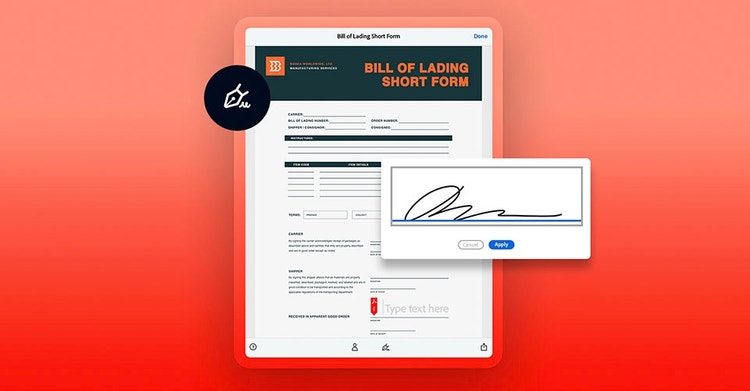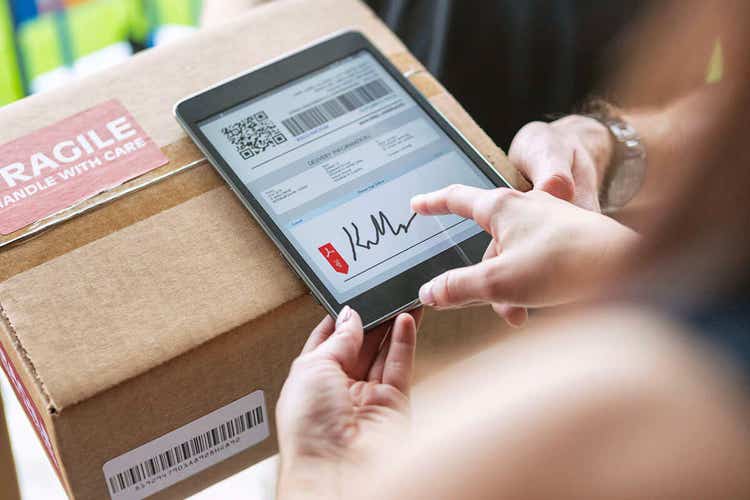Adobe Acrobat Sign
What is a bill of lading (BOL) form?
Discover why you need a bill of lading to securely transport and deliver goods and learn how to create your own form.

Bill of lading forms, explained.
The bill of lading (also known as a BOL, or B/L) is a legal agreement that covers the shipping of goods and products. This document is used by the shipper of the goods (consignor), the receiver of the goods (consignee), and the shipping carrier that actually transports the goods. Like a bill of sale, it includes details about the goods and the recipient, but it also contains the delivery destination and additional important information.
Bill of lading forms are most commonly used by manufacturers and distributors that regularly contract trucking firms and other freight carriers to transport their goods. (In fact, many large companies use separate logistics partners just to help them generate, track, and manage all that paperwork.) Bills of lading are legally required to move goods from one location to the next — shippers can’t ship and receivers can’t accept deliveries without them.
Each bill of lading is actually two documents, each containing the same information. Both copies must be signed by the shipper and then also by the receiver when the shipment is delivered. (In addition, the driver signs on the carrier’s behalf.) If you use paper forms, you’ll have two physical copies of every BOL. With an electronic document, you’ll only need to sign once — chalk up another point for digital workflows.
Why do you need to use a bill of lading?
First, because it’s legally required. But the bill of lading also serves several important purposes.
Contract, receipt, and title.
The BOL is a contract of carriage between the shipper and the carrier, representing the agreed terms and conditions for transporting the goods. Once the bill of lading is signed by the receiver, it serves as a receipt for the goods that have been shipped. In between, the bill of lading is effectively a document of title (DOT) for those goods. This mutual accountability provides important legal protections for everyone involved in the shipping process and helps keep track of goods in transit, regardless of the modes of transport used.
Payment information.
Bill of lading forms are also used to detail freight charges, fee terms, purchase orders, and invoicing related to the shipment. Some shippers require full prepayment for their goods, while others accept a down payment to be followed by a Collect on Delivery (COD) amount. The bill of lading outlines those charges and directs the carrier how to accept payment on the shipper’s behalf.
Liability limitation.
If the items in a shipment are delivered in good order and proper condition, the receiver’s signed bill of lading simply serves as a receipt. But if goods are lost or damaged in transit, bills of lading (along with liability waivers) can help resolve disputes over who’s responsible for what.
The type of BOL you use will also impact liability issues. Straight bills of lading, for example, are non-negotiable forms used primarily to deliver prepaid shipments directly to designated receivers.
Use the shipping form that fits the bill.
There are somewhere around 15 to 20 different types of bills of lading, depending on how you categorize them. Various lists group them according to the type of carrier, or payment mechanism, or liability posture, or delivery variables, or myriad other factors within the complex world of global shipping. Additional groupings focus simply on the mode of transport. Several of the major types are briefly described here.
Order bill of lading, Open bill of lading.
Order bills are the most commonly used type of BOLs worldwide. They’re popular for global transactions for two reasons. First, the shipment can only be delivered to the person named on the form. This prevents cargo from being delivered to unwanted parties. Second, the bill is negotiable. Once the receiver has accepted delivery, they can transfer the title (ownership) of the goods to any other party. The Open bill of lading is similarly negotiable, letting the receiver sign off on a shipment to transfer ownership to a different consignee.
Straight bill of lading.
The Straight bill is exactly the opposite of Order bills of lading. Everything is straightforward, as the name suggests. All the terms are outlined, and nothing can be changed. The seller agrees that a certain form of transportation will be used to ship certain goods to a specific party at a certain location. By making complete payment in advance, the receiver gets direct delivery of the shipment. This is also sometimes called a Consignment bill of lading, because the goods are consigned to one specific person who must receive the delivery and has no way to transfer that right to anyone else. (That’s what makes this particular form non-negotiable.)
Clean bill of lading, Dirty bill of lading.
Clean and Dirty bills of lading also live up to their names. The Clean bill of lading is issued by the carrier after inspecting the goods at delivery. This form establishes that the shipment was received in good condition, in the correct quantity and packaging, and that no damage was sustained during transport — therefore the packaging and goods can’t later be declared defective.
A Dirty bill of lading outlines loss or damage that has occurred during shipment, or other discrepancies to the cargo at the point of delivery which might cause the receiver to refuse acceptance or their bank to refuse payment. The original bill would otherwise have been a receipt for the delivered goods. Now it contains clauses outlining the quality defects or quantity shortfalls, so it’s sometimes also known as a Claused bill of lading.
Through bill of lading, Multimodal bill of lading.
The Through and Multimodal bills are also closely related. The Through bill of lading allows shipments to move from one distribution center to another, through domestic and international borders, and between different modes of transport. In each case, the carrier is moving goods across several destinations. (An Ocean or Inland bill may also be needed to complete these shipments.)
The Through bill usually involves a single form of transport, but with multiple steps to the journey. The Multimodal bill, by contrast, is sometimes also known as a Combined transport bill of lading. It’s used for shipments involving at least two methods of cargo movement — for example, a package that travels by train to a port, where it boards a ship before riding on a truck to its final destination.
Short Form bill of lading.
The Short Form bill of lading provides a minimalist solution for routine or low-risk shipments. This simplified form is also known as the Blank Back bill of lading, because no terms and conditions for the contract of carriage appear on its reverse side. (The shipper may or may not reference a website or some external document that contains this standard contractual information.) Only the most basic items appear on this form: contact information for both parties, shipment details, instructions, and the required signature lines.
Other common bills of lading.
A Master bill of lading, also called a Carrier BOL, is sometimes issued by the trucking company, shipping line, or other carrier that owns a transport vessel being used for shipment. Cargo shippers normally only receive a Master bill if they are working directly with a mainline carrier or freight forwarder. The Ocean bill of lading applies primarily to overseas shipments using ocean freight. This bill is needed when goods are being transported to another country through international waters.
Goods that must travel across land before reaching shore may need an Inland bill of lading, which covers domestic shipments delivered only on land (whether by rail or road). Packages that take wing will use an Airway bill of lading, another non-negotiable instrument, which is usually issued by the air freight forwarder.
Ready to create a bill of your own?

What to include in your bill of lading form.
Since bills of lading are legal documents, they vary for domestic and international shipments and also according to the type of goods being carried and the form of transport being used. But all of them include these major components.
Basic information.
Note the names, addresses, and phone numbers for both the shipper and receiver. Also add the date of the shipment and assign a bill of lading number.
Freight classification.
The National Motor Freight Classification (NMFC) system simplifies and streamlines freight categorization and pricing. This classification is calculated based on the weight and density of the freight shipment, its value and security requirements, its loading and handling specifications, and its stowing capacity. With less-than-truckload (LTL) freight shipping, for example, shippers pay for just a portion of the carrier’s truck.
Shipment details.
Outline the number of shipping units and the exact weight of the shipment. If there are multiple freight units, then each item’s weight should be listed.
Provide a detailed description of the goods being shipped, in addition to the number of units. Specify the type of packaging, including cartons, pallets, and drums, plus the name of the manufacturer.
Add the declared value of the property and the total cost of shipment and include any special account numbers either party will use to track the order.
Special instructions.
If the goods are fragile, or if there are specific handling instructions, make note of them in your bill of lading.
Hazardous material.
If your freight includes items classified as hazardous by the Department of Transportation, or items that could harm the public or the environment, add that information to your BOL.

Save time and simplify freight management with digital documents.
The tools in Adobe Acrobat Pro can save time and money as you manage your bill of lading forms. E-signatures powered by Acrobat Sign, together with Adobe’s online fill and sign application, help shippers, carriers, and consignees turn freight paperwork around quickly and securely.
In addition, you can create and customize your own bill of lading templates to use over and over again. Shipping and receiving managers, logistics specialists, accounting and billing personnel, drivers — everyone involved with freight management — can easily sign, exchange, track, and archive documents of all kinds faster than ever with Acrobat’s digital workflow processes.
Some frequently asked questions about bill of lading forms.
What is a short form bill of lading?
The Short Form bill of lading is an abbreviated document that meets legal requirements but provides a bare minimum of shipping information. It is most suitable for use with routine or low-risk shipments. The highly simplified form is sometimes also known as a Blank Back bill of lading, because no terms and conditions for a contract of carriage appear on its reverse side as they normally would. The form includes only the most basic items: contact information for both parties, shipment details, instructions, and the required signature lines.
Where can I find a bill of lading template?
A quick online search for “bill of lading templates” will yield dozens of pages of results for templates you can use right away to create most any type of bill of lading. There are commercial versions available from companies that produce online forms and documents, free versions from various sources, and annotated versions offering helpful guidance and step-by step instructions from freight industry experts. Most of these include either PDF or Excel downloads that are fillable and printable. Don’t see a template that fits the bill? Create your own template in Adobe Acrobat Pro.
What's an example of a bill of lading?
There are lots of free samples online of blank bills of all types. A search for “bill of lading examples” will turn up plenty of results. A little more digging will get you some annotated versions from freight industry pros who can help guide you to the correct form to use for your shipping needs, and maybe even some step-by-step advice on how to fill them out. Once you find a sample that fits your needs, you can use it as a model to create your own template in Adobe Acrobat Pro.
